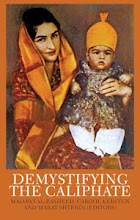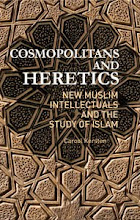The event was kicked off by Professor Derek Gregory, a British-born geographer now teaching in Vancouver who has done important work on political and cultural geographies of late modern war -- a topic that seems to present itself almost automatically when dealing with a highly volatile region like the Middle East, and which for that reason is very illustrative of what Gregory called the 'Project of Cartographic Reason'. He used his presentation to problematise the designation 'Middle East', not only as a topographic term referring to a concrete place as such, but also as a less tangible concept with important cultural-political connotations. The significance of this point became clear throughout the conference, as participants struggled to come to terms with the subject area; using 'Middle East' interchangeably with 'Arab', or even 'Islamic World' demonstrated the widespread tendency to conflate these designations of evermore expansive regions. (Art historian Nada Shabout, author of Modern Arab Art: Formation of Arab Aesthetics
Gregory referred to Juan Cole's Napoleon's Egypt
Topography becomes connected with the politics of culture when the Eurocentric gaze projects the Middle East as an alien space, a 'tableau of queerness' (Edward Said in Orientalism
London-based architect Eyal Weizman agreed with Gregory's observations, recalling the cartographic projections of Israel as a tiny blue spot in the surrounding red mass of the Middle East. Israeli perceptions of space see the Middle East not only as surrounding the Jewish Homeland; it is also 'inside' -- the Palestinians resident on its territory. For Weizman this affirms that the cartographic representations used in topography and geography are political subjectivities, which not only 'shape' the world, but also affect the way you act in it. To him this only underscores the importance of coming up with counter strategies for these campaigns of geographic warfare.
Issa Touma, an autodidact photographer who runs Le Pont Gallery in Aleppo, used the features of the Arab house as a metaphor for the challenges artists established in places like his native Syria face. Grim-looking exteriors hide often well-decorated interiors. Big walls discourage communication with the outside world, high windows are there to 'spy' on 'the street'. To an extent these residences are jails, as their design assists the familial patriarchs to exercise control. The same applies to many Middle Eastern societies at large, as Touma experienced himself: his gallery was repeated closed by the government. Because so much remains out of sight, Touma agrees that media images of anger, flag-burning, and violence, on the one hand, and the projection of a dreamy 'Arabian nights' utopia, on the other, will not be challenged easily. He believes therefore in the importance of contemporary art for showing reality -- which should also include people's dreams.
Aside from 'space' -- including its slippage into a variety interpretations -- other buzzwords circulating throughout these two days were 'diaspora' and 'movement'. The fluidity of these interpretations is reflected in events such as Homeworks in Beirut, and The Flying House initiative of Abu Dhabi art collector Abdul-Raheem Sharif, which showcases the work of Emirati artists since the 1970s (including those of his brother Hassan Sharif).
The inherent hybridity of such notions conjure up associations with fields like cultural studies and postcolonial theory, while the production and function of contemporary art outside the 'metropoles' of Berlin, London, Paris, and New York is indicative of the collapse of the West vs 'the rest' dichotomy. In his talk about the relationship between 'Tradition and Modernity', Cornell art historian and Africanist Salah Hassan invoked Stuart Hall's claim that the binaries of West/Non-West and Centre/Periphery are increasingly challenged by the creative ideas germinating in the spaces 'in-between'.
Panelists like photographer and video artist Zineb Sedira spoke of diaspora as an almost sine qua non condition for cutting-edge artists originating from the Middle East and North Africa. Paris-born but of Mauritanian extraction, now residing in London though holding dual French-Algerian nationality, her own biography appears to confirm this.
In a similar vein, Tangiers-based Yto Barrada noted the importance for MENA (Middle Eastern & North African) artists to be able to move around, because the local cultural environments are often still bleak and barren. However, with all the travel obstacles they currently find in their way, it proves difficult to establish contacts with fellow artists, curators and other culture brokers.
This issue of 'brokerage' was addressed in a panel session on Writing and Translation, opened by the renowned Palestinian poet and author of I Saw Ramallah
The understanding of non-Western literatures is not only hampered by a lack of nuance or unfamiliarity with local languages, but the absence of translations in European languages of writings on philosophy and history by Middle Eastern intellectuals. Arabs and others remain caught in the dichotomy of demonisation vs romantisation, which continues to oscillate between the images of Caliban and those emerging 'fresh from the hands of the Gods'. While Asians, Africans and Latin Americans are expected to acquaint themselves with the Western canon -- and should realise the rare privilege conferred upon by the provision of translations in their own vernaculars -- the reverse traffic is a still a mere trickle, an occasional favour bestowed on only a few select cultural giants.
Aside from the question of what gets lost in translation, or -- in the case above -- what is read into it, moderator Salah Hassan also amplified the role of other 'culture brokers' than literary translators. Laudable initiatives such as Bidoun, which provides a forum for discussing arts and culture in the Middle East, or the online journal Nafas, dedicated to promoting 'contemporary art from Islamic influenced countries and regions', are indicative of the artistic vibrancy in the Middle East/Arab World/Dar al-Islam.
Published in New York, Bidoun is presently run by founder Lisa Farjam and editor-in-chief Negar Azimi, who was previously associated with the Townhouse Gallery in Cairo and the Beirut-based Fondation Arabe pour l'Image. Supported by IFA, the German Institute for Foreign Cultural Relations, Nafas is part of the wider Universes-in-Universe platform, founded as far back as 1997 by Gerhard Haupt and Pat Binder and providing a forum (in English, German, Arabic and Spanish) for discussions on art from Africa, Asia, and Latin America. As someone with a vivid interest in all things Southeast Asia, I was particularly pleased with Haupt's report on a recent six-week presentation tour to Malaysia, Indonesia and Singapore, introducing the 'East' to the 'further East'. Although 'dedicated to contemporary art from the Maghreb to Southeast Asia, from Central Asia to the Middle East', the name 'nafas' -- from the Arabic for 'breath' -- was a deliberate choice to emphasis the individuality of the artists and steer away from presenting 'the' Muslim world as a monolithic whole.
This clarification touches on an important observation made by Salah Hassan, that aside from the interesting things evidently fermenting under the surface,there is currently also something of a 'hype' going on. In the wake of the post-9/11 surge in demand for information on all 'things Islamic', there was also an eruption of presentations, exhibitions, etc. on cultural developments, while prices of Middle Eastern art skyrocketed. Although this may be potentially good news for artists from the region, there is also a tendency on the part of museum directors and event curators to invite the same faces over and over again. Prince Claus Award recipient Christine Tohme showed her frustration over the fact that, sixteen years after launching the Askhal Alwan initiative, she is still one of the first calling points for anyone with the intention of organising something on Middle Eastern art. It made her wonder to what extent the contemporary art establishment in the West is aware of the dynamism and ongoing development of the arts in the field.
Also symptomatic of this state of affairs is the undeniable trend towards large-scale, and therefore expensive, undertakings, especially in the Gulf states. A number of conference presenters and discussants are themselves in one way or another 'implicated' in this (although the degree in which they were comfortable with this varied). Aside from Christine Tohme, Jack Persekian, founder of Jerusalem's Al-Ma'mal Foundation for Contemporary Art and Artistic director of the Sharjah Biennial, and Townhouse Gallery founding director William Wells, serve on the curatorial advisory committee of the Guggenheim Abu Dhabi project, which envisages the construction of a behemoth museum complex for contemporary arts on an island off the coast of this oil-rich emirate.
For this tremendously ambitious -- and money-swallowing -- plan, the initiator, Abu Dhabi Crown Prince Sheikh Muhammad bin Zayid al-Nahyan, called on now former Guggenheim Director Thomas Krens and the Louvre in Paris, while renowned architect Frank Gehry was commissioned with the design.
The ambivalence surrounding such money-driven projects were also addressed by Shumon Basar's eloquent and humorous closing presentation on 'The Politics of Space'.* Inspired by Italo Calvino's festina lente, he captured the question whether the UAE art scene is held hostage in a political hijacking by a mixture of petrodollar grandeur, royal megalomania and parvenu Nouveau Riche in the catchphrase 'speed of forms, slowness of contents'.
* Somewhat ironically, Basar, co-editor of the acclaimed anthology of Middle Eastern architecture With/Without
Although, as one of the delegates noted, also in the Middle East (the) art (world) appears to follow the money, it evinces also there is a degree of self-reflection and questioning of such practices among those involved. In that respect, politics could take an example from the art world.






